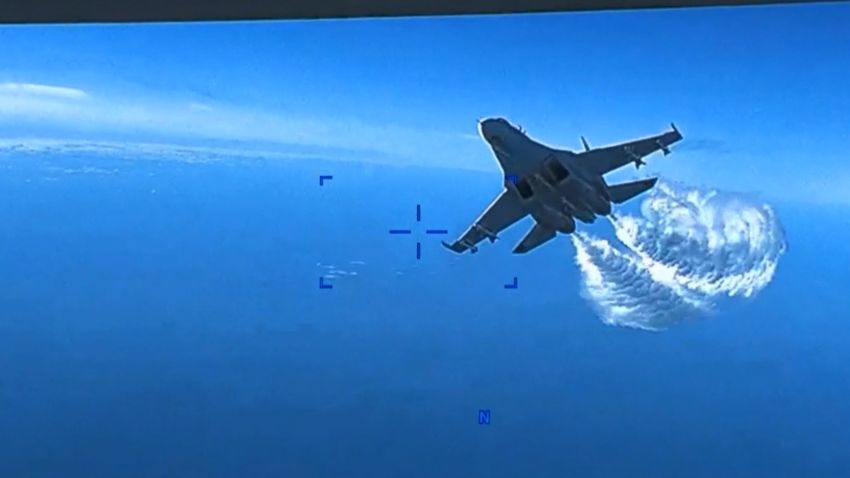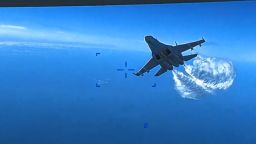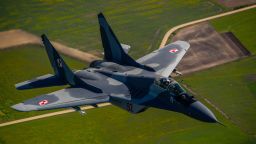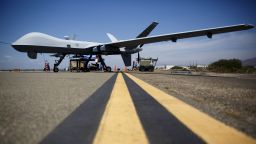The stunning aerial video of a Russian jet buzzing and then apparently hitting a US drone over the Black Sea vividly shows how the war in Ukraine could spin out of control.
But if there is anything comforting to take away from the drama, it seems the two nuclear powers are determined to prevent that worst-case scenario of the conflict from happening.
Clearly, the showdown, which has resulted in angry rhetoric being flung between Washington and Moscow but nothing more, would have been far worse if the US Reaper drone that was downed had been a manned aircraft.
The fact a drone was involved has allowed both sides to calibrate their language to avoid an escalation. It has also shown the value of military to military contacts between Russia and the US. Secretary of Defense Lloyd Austin revealed on Wednesday that he had spoken to his counterpart in Moscow. And Gen. Mark Milley, the chairman of the Joint Chiefs of Staff, said he had similar contacts planned. In another theater of operations, the Pacific, where US and Chinese jets and ships often come in close contact, such military-to-military dialogue has been suspended at various points – a scenario the incident over Ukraine reveals as highly dangerous.
Tensions between Russia and the West that were worsened by the drone incident are likely to ramp up further with the news that Poland will send Ukraine four MiG jets that were once in the inventory of the former East Germany in the Cold War-era Warsaw pact. The move marks an important milestone in the West’s aid to Kyiv and answers a long-standing request by the government there. But it is not as inflammatory as a decision to send more advanced US-made F-16 planes at Ukraine’s request would have been. The US and its allies have so far not signed off on such a step.
Milley said on Wednesday that the drone incident was the latest in a pattern of an increasingly aggressive behavior by Russian pilots that the US needed to seek clarification about. And the reverberations of the drone downing are likely to have prolonged consequences.
“When an unmanned mission like this one is impacted, the impact is not as great as if it were a crewed aircraft,” retired Brig. Gen. Cedric Leighton said on “CNN Newsroom” on Thursday. But he added that video footage of the incident made an important point. “Every time something like this happens … it’s very important for everyone who is watching this to really understand that when Russia makes pronouncements, they are either giving you half-truth or no truths.”
One of the most alarming aspects of this collision is that it took place in international airspace – not over Russian territory or the battlefield – and thus underscores how US and Russian forces could come into contact even outside the war zone.
Dramatic footage
On the face of it, the footage released by the US on Thursday, which shows a Russian warplane swooping in behind the drone while seeking to dump fuel on it, appears to puncture Moscow’s narrative that there was no mid-air contact. While the moment of coming together isn’t clear on the US tape, the video does appear to pixilate, suggesting a blow as the plane passes the drone at high speed. Then there is footage of the aircraft’s damaged rear propellor.
The video is the latest episode of the Ukraine conflict in which the United States and its allies have used declassified material to refute Russia’s claims and to wage an information war with the Kremlin. In this case, it appears to prove Pentagon arguments that the conduct of the Russian pilots was “unprofessional.”
The next point of potential tension arising from the incident will come if Russia is able to recover debris from the drone as it seeks an intelligence coup. Several US officials have publicly said remote American pilots wiped sensitive information from the drone before crashing it into the sea. The Pentagon said Wednesday the glider was lying in between 4,000 and 5,000 feet of water and that it was probably in small pieces. Yet Russia is sure to use any debris of the craft for propaganda purposes even if they yield no useful intelligence.
Later on Wednesday, CNN reported that the US believes Russia has recovered some debris, according to a US official familiar with the matter. The official described the recovered wreckage as pieces of fiberglass or small bits of the drone.
Given the fractured state of US politics and the willingness of Joe Biden’s opponents to use national security incidents to portray the president as weak, this could make for some uncomfortable moments for the White House. Such a move by Russia, as well as the shocking clarity of the Pentagon video, could also further inflame a debate over Ukraine in the Republican presidential race, with key players like Florida Gov. Ron DeSantis, a possible candidate, arguing that the US has no vital national interest in being further drawn into what he says is a territorial dispute between Russia and Ukraine.
Both sides seem to want to move on
One of the most worrisome aspects of a war in which the US and its allies are pumping in billions of dollars of ammunition and sophisticated arms to be used against Russian forces is the possibility of a miscalculation or incident that could cause a direct clash between Russian and NATO assets.
In some ways, this is what happened over the Black Sea this week. CNN’s Natasha Bertrand and Kylie Atwood reported Wednesday that senior Russian defense officials approved the harassment of the drone, according to two US officials familiar with intelligence about the incident. So it’s plausible that this escalation was a deliberate decision to send some kind of message to the United States by Moscow or to try to deter US intelligence gathering near Ukraine. After the mid-air clash, officials in Russia said relations between the two former Cold War rivals were at their “lowest point.”
But after being summoned to the State Department, the tone of Russia’s ambassador to the US Anatoly Antonov was not inflammatory. The conversation was “very calm” and “respectful” and “I categorically denied all accusations against the Russian armed forces,” Antonov said. “No one hit the table with a shoe, threatening something,” he added.
And Milley and Austin, while being scathing about Russia’s conduct in the war, also indicated that Washington did not wish to take the incident further.
“We take any potential for escalation very seriously and that’s why I believe it’s important to keep the lines of communication open. I think it’s really key that we’re able to pick up the phone and engage each other. And I think that that will help to prevent miscalculations going forward,” Austin said. Milley, meanwhile, declined to categorize the mid-air clash as an act of war, adding, “Incidents happen and clearly, we do not seek armed conflict with Russia. And I believe that at this point we should investigate this incident and move on from there. But we will continue to exercise our rights in international airspace.”
Russia has complained that the US drone infringed its self-declared air rules over the Black Sea. But this is a risible position given its own huge violation of international law with an unprovoked invasion of a sovereign state.
But the footage of the high-speed airborne clash shows that as long as the Ukraine war goes on, and the West is involved, even indirectly, the possibility for an escalation that could expand the conflict in a disastrous manner will constantly exist. And it will take careful management in both Washington and Moscow to lower the risk.








